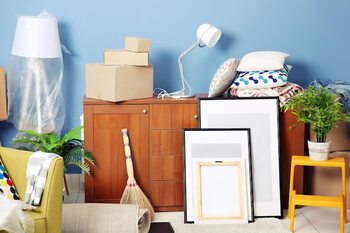Creating a functional home: the key to your move

Creating a functional home is essential for starting your new life in a different space on the right foot. In this article, we will present a practical checklist that will make your move easier and ensure that every corner of your new home meets your needs. With useful tips and proven strategies, you will discover how to transform any space into a cozy and efficient environment, where you can enjoy the tranquility and comfort you deserve. Get ready to make your move a positive and exciting experience!
1. Establish your priorities: What do you really need?
Establishing your priorities is a fundamental step in the moving process and in creating a functional home. Before filling boxes and making decisions about what to take with you, it is crucial to reflect on your actual needs. Ask yourself: what spaces are essential for your well-being? Make sure to identify the areas that you truly use daily, such as the kitchen, the bedroom, or an office if you work from home. By doing so, you will be able to focus on those elements that will enhance your quality of life and avoid carrying unnecessary items that will only take up space.
Once you have defined your priorities, it's time to create a clear list of what you need. This checklist should include not only essential furniture and items but also those articles that bring you comfort and happiness. Consider aspects such as adequate storage, decorative elements that reflect your personal style, or technological devices that facilitate your daily life. By having a clear understanding of what you truly need, you can make a more efficient and effective move, ensuring that every corner of your new home is designed to serve your specific purposes and needs.
2. Space planning: Functional design from the start
Space planning is a crucial step to ensure that your home functions optimally from day one. Before unpacking the boxes, take some time to visualize how you want each area to be used. Consider the arrangement of furniture, natural lighting, and the flow of movement between rooms. A functional design not only enhances aesthetics but also maximizes efficiency by allowing you to move easily and access what you need without complications. Spend a few minutes sketching a simple plan, whether on paper or using digital apps, to ensure that each piece of furniture has its proper place.
It is also essential to consider the specific needs of all household members during this planning stage. Ask yourself how spaces are typically used and if there are areas that could be better adapted for different activities or daily routines. For example, if you have children, consider creating a separate play corner to keep the clutter under control. If you work from home, a well-placed office can help establish clear boundaries between work and leisure. By thinking about these details from the beginning, you will be building a home where everyone can feel comfortable and productive, which is key to fully enjoying your new life in this renovated space.
3. The Art of Packing: Tips for a Stress-Free Move
The art of packing is essential to ensure that your move goes smoothly. Start by gathering all the necessary materials: boxes of different sizes, adhesive tape, bubble wrap, and markers. Organizing your belongings into categories will make the process easier; group similar items and label each box with its contents and the room they belong to. This practice will not only help you find what you need in your new home, but it will also allow you to identify the things you really use, helping you get rid of the unnecessary before the move.
An additional tip is to pack an "essentials box" that contains everything needed for the first few days in your new home: personal hygiene items, comfortable clothing, basic kitchen utensils, and important documents. By keeping these items on hand, you can settle in more quickly without feeling overwhelmed by the unpacking process. Also, remember to take care of fragile items; wrap them properly and place them in boxes labeled as "fragile" to avoid accidents during the move. With an organized and methodical approach, you will make your move a much more relaxed and efficient experience.
4. Moving Day Checklist: Everything You Must Not Forget
A move can be an overwhelming process, but a moving day checklist will help you keep everything under control. Before the trucks arrive and the hustle and bustle begins, make sure to consider essential items like important documents, basic tools, and cleaning supplies. Having your identification, lease or purchase agreements, and any other relevant documents on hand will prevent unpleasant surprises. Additionally, having tools like a screwdriver or tape will facilitate the immediate assembly of furniture in your new home.
Don't forget to create a "survival kit" for the first day in your new house. This kit should include essential items like comfortable clothing, personal hygiene products, and some basic cooking utensils. It's also helpful to include snacks and water to keep you hydrated and energized during the process. This attention to detail will allow you to settle in more quickly and enjoy the new space without feeling overwhelmed by the immediate need to unpack everything. With this well-organized checklist, you can focus on what really matters: making your new home functional and welcoming from the very first moment.
5. Post-Move Organization: How to Quickly Get Rid of the Chaos
Post-move can be overwhelming, but with a good action plan, you can get rid of the chaos quickly. Start by establishing organization zones in your new home. Dedicate a specific space for each category of items: kitchen, living room, bedroom, and bathroom. This will not only help you visualize the process better but will also promote a sense of order and control from the beginning. As you unpack, make sure to place items in their designated spot; this will prevent boxes from piling up and creating more clutter.
Another key piece of advice is to take a detailed inventory of your belongings before and after the move. By knowing exactly what you have and where everything is, you can identify what is essential and what is unnecessary. Take this opportunity for decluttering: donate or sell those items that you no longer need or that do not fit in your new space. This process will not only lighten the physical load in your new home but will also help create a more harmonious and functional environment where you can truly start enjoying your new life.
6. Suitable furniture: Selection to maximize space
Choosing the right furniture is essential to maximize the space in your new home and ensure that each area is used in a practical and functional way. By selecting pieces that fit the dimensions and characteristics of your rooms, you will be able to optimize circulation and create a more welcoming environment. Opt for multifunctional furniture, such as sofa beds or extendable tables, which not only save space but also offer versatility for different situations. Additionally, consider the height and design of the furniture; lower models can make a room appear more spacious, while vertical shelves make the most of wall space.
Don't forget to pay attention to the style and colors of the chosen furniture, as these elements also influence the perception of space. Light tones tend to visually enlarge rooms, while furniture with exposed legs can create the illusion of a more open area. Additionally, make sure to leave enough space between pieces to facilitate movement and avoid a cluttered feeling. Remember that each element should have a clear purpose; this way, you'll achieve not only an aesthetically pleasing home but also one where every corner is designed to meet your daily needs.
7. Functional decoration: Beauty with purpose in every corner
Functional decor is the key to achieving a home that is not only aesthetically pleasing but also practical and welcoming. Every element in your space should have a purpose, from furniture to decorative accessories. By selecting pieces that align with your daily needs, you can maximize the use of every corner of your home. For example, a sofa that includes storage or a coffee table that serves as additional workspace are perfect examples of how beauty can go hand in hand with functionality. The key is to choose elements that reflect your personal style while meeting the demands of daily life.
Additionally, it is important to consider how each area of your home can be transformed through smart decorative solutions. Integrating floating shelves in the living room, using decorative baskets to organize toys, or implementing strategic lighting can work wonders in the perception of space. Don't forget that each object can tell a story and add character to your new home; thus, while optimizing its use, you create a warm and inviting atmosphere. In this way, you will be contributing to a more organized and pleasant life, where every corner serves its purpose without sacrificing the style or warmth of the place you now call home.
8. Adapting technology to your new home: Integrating smart solutions
The integration of technological solutions in your new home can transform the way you interact with your space, making it more efficient and comfortable. From smart lighting systems that adjust to your preferences to thermostats that regulate the temperature according to your daily routines, technology can help you create a personalized environment. By considering devices like voice assistants or connected security cameras, you will not only improve the functionality of your home but also increase your peace of mind knowing that you have total control over every corner.
Additionally, it is important to think about how these solutions can be integrated without complicating the design and aesthetics of the home. Choose products that are compatible with each other and that offer a seamless experience for the user. For example, you can set up a home automation system that interconnects lights, appliances, and electronic devices to simplify daily tasks. By doing so, you will not only optimize the use of space but also promote a more sustainable lifestyle by reducing energy consumption. Adapting technology to your new home is a valuable investment that will allow you to fully enjoy comfort and modernity in every moment of your daily life.
9. Create specific zones: Multifunctional spaces that enhance quality of life
Creating specific zones in your home is a key strategy to maximize functionality and improve your quality of life. By defining multifunctional spaces, you can tailor each area to your daily needs, whether it's a reading nook, a workspace, or an entertainment zone. For example, integrating a desk in the living room or converting a corner of the bedroom into a small gym can optimize space usage without sacrificing style or comfort. This flexibility allows you to enjoy an environment that adapts to your daily activities and fosters a more balanced life.
By creating these specific zones, you also contribute to maintaining order and organization in your home. Having designated areas for different functions not only facilitates daily activities but also helps reduce the stress associated with clutter. You can establish smart storage solutions that seamlessly integrate with the decor, ensuring that every item has its place. This way, you not only enhance the functionality of the space but also create a visually appealing and harmonious environment where every family member can feel comfortable and productive.
10. Maintaining long-term order: Strategies for a consistently functional home
Maintaining long-term order is essential to ensure that your home remains a functional and welcoming space. One of the most effective strategies is to establish daily routines that promote organization. Spend a few minutes each day on simple tasks like making the bed, putting away misplaced items, and cleaning surfaces. This small daily effort not only prevents clutter from building up but also creates a more pleasant environment in your home. Additionally, consider implementing an accessible and clear storage system; use labeled boxes or specific shelves for each category of items, making it easier to locate and return them after use.
Another key strategy is to regularly review your belongings and get rid of what you no longer need. Scheduling monthly "decluttering days" will allow you to assess which items are truly useful and which can be donated or recycled. This practice not only frees up physical space but also helps maintain a minimalist mindset focused on the essentials. Finally, remember to involve all household members in the organization process; assigning shared responsibilities fosters a culture of ongoing order and ensures that everyone feels part of the maintenance of the functional home you wish to create. Thus, with these simple yet effective strategies, you can enjoy a consistently tidy and harmonious home.



